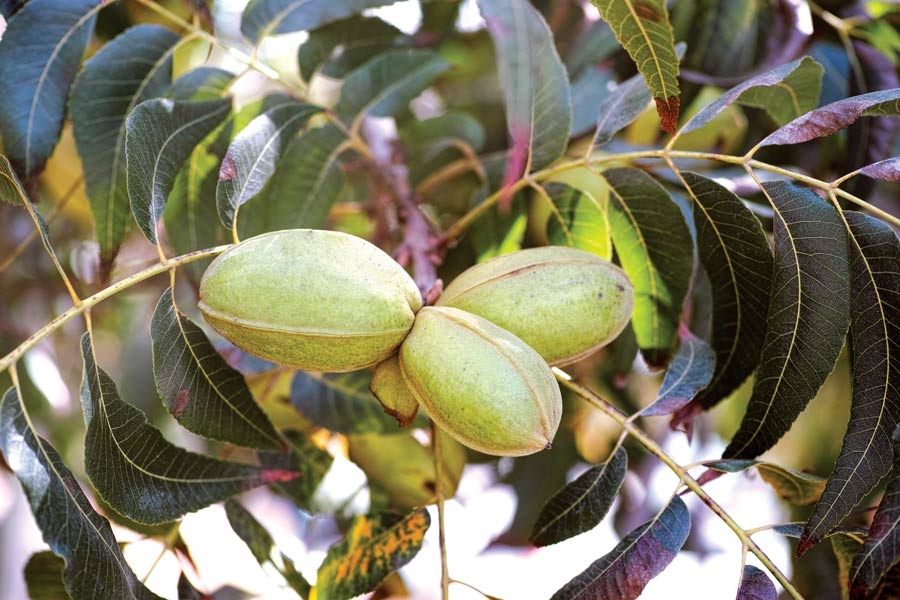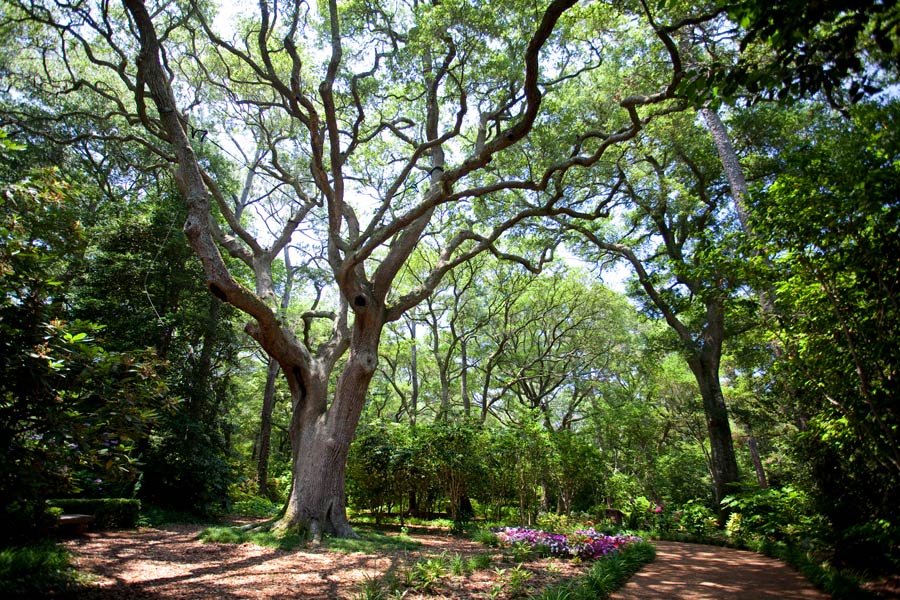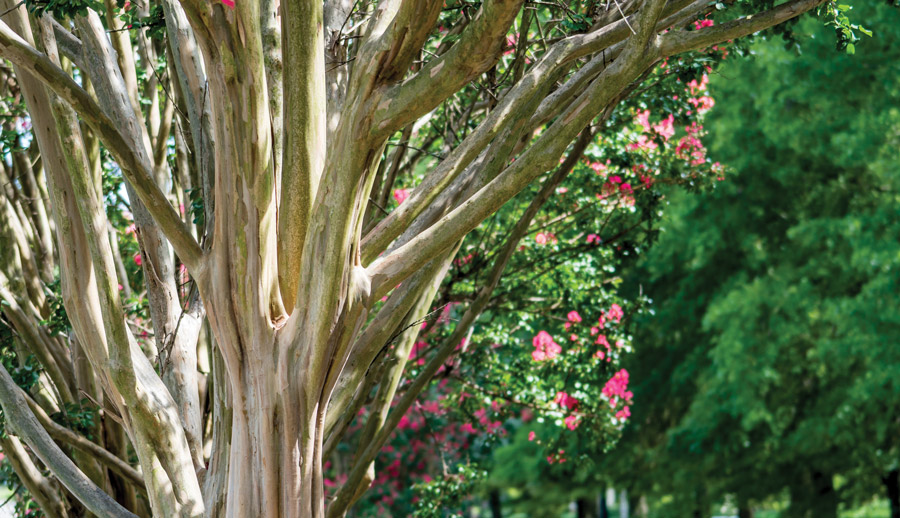
"Trees give peace to the souls of men." - Nora Waln
The Outer Banks is one of the best places on the planet to bask in the healing powers of Mother Nature. While most people might come here to connect with the watery elements of the world, these islands also offer plentiful opportunities to commune with trees.
Trees are simply vital to our existence. Of course, they provide breathable oxygen and repurpose our carbon dioxide, and they provide timber, fuel, shelter for birds and animals, food, medicine, shade and beauty. But trees are also good for our well-being, helping us feel peaceful and grounded. Researchers of Japanese forest-bathing (a term for spending time in the woods) are now proving that being among trees helps lower blood pressure, heart rate and the stress-fueled hormone cortisol. A new field of eco-psychology is based on the premise that trees help calm and clear our minds and ease our emotional stresses. Whether in forests or standing alone, trees offer a healing and joyful presence and richness to our landscapes.
You might not think of trees when you think of the beach. On the barrier islands of Bodie, Hatteras and Ocracoke, the harsh, salty environment near the ocean is not conducive to the growth of trees; any trees that do root near the beach are usually stunted in growth and weathered in the direction of the prevailing NE winds. But in pockets of maritime forest on the salt-protected soundside areas of the islands, there are flourishing stands of yaupon, red cedar, white cedar, loblolly pines, hickory, beech, cypress and live oak, many of them quite old. On Roanoke Island and the mainland, which are much more protected from the salt air and harsh winds, there is an even greater diversity of trees.

Southern Live Oaks
The largest and most striking trees on the Outer Banks are the sprawling old Southern live oaks, Quercus virginiana, some of which have been here for more than 400 years. These trees are landmarks, witness to history of the time when Native American tribes roamed these grounds and the Spanish and English explorers first came calling. The largest of these trees are held in such regard that they are protected, named and registered with the Live Oak Society, a membership organization for mature live oaks. (To see the full list go to lgcfinc.og/live-oak-society.html.) To be a member of the society, a live oak must have a trunk diameter of 8 feet or greater, measured at 4.5 feet above ground. Manteo resident John Wilson says that a horticulturalist once told him that a live oak could live up to 1,200 years in the right conditions – the first 400 for growth, the second 400 for enjoying life and the last 400 for slowly dying.
There are thousands of live oaks on the Outer Banks, but a few are standouts.
Giant Oak
In The Elizabethan Gardens on Roanoke Island, the ancient Giant Oak has been dated to 1585 by tree ring borings – making it more than 400 years old. Locals say that before the gardens were established, the tree was used for variety of tasks, like hanging animal carcasses and hauling engines out of vehicles. Thanks to former gardens’ superintendent Louis Midgette and others, the tree was saved from bleeding canker disease. It is a healthy and very impressive specimen with a circumference of 13 feet, and it is a magnificent centerpiece to The Elizabethan Gardens.
Khoury Oak
This oak has a 16.02-foot circumference, which presumably dates it at least 100 years older than the Giant Oak in Elizabethan Gardens. A local nonprofit known as Outer Banks Conservationists preserved this precious tree by purchasing the undeveloped lot on which it sits in 2012. The address is 1050 U.S. Highway 64 in Manteo.
Chrissy Oak
Island Farm on Roanoke Island, also owned by Outer Banks Conservationists, is a historic site where the public can learn about island life in the 1850s. It is the re-creation of the Etheridge family farm. Onsite is the Dan Redding Oak (circumference 8.11) and the Etheridge Tree (circumference 12.10). Nearby at 150 Etheridge Road is The Chrissy Oak (circumference 10.2), an ancient tree named for Christaina Bowser, a free woman of color who lived to around 100 years old near the Etheridge Farm on Roanoke Island in the late 1800s and early 1900s. She was a legendary Roanoke Islander and died a landowner, a remarkable feat for a woman in that time — most especially for a woman of color.

The Cora Tree
A famous live oak in the village of Frisco on Hatteras Island is the Cora Tree, which is presumed to be several hundred years old. Author Charles Harry Whedbee wrote about the tree in his book Blackbeard’s Cup and Stories of the Outer Banks. The letters CORA are carved into the tree, and as an explanation, Outer Bankers tell this tale. In the early 1700s a woman named Cora and her baby arrived on Hatteras Island. The woman lived in a solitary hut and did not socialize. After her arrival, strange things began to happen, and the suspicious islanders accused her of sorcery. They tested her to see if she was a witch, and Captain Eli Blood, living on the island at the time, declared it was so. Determined to burn her alive, he tied her and the baby to an oak tree. Rain began and a bolt of lightning struck the tree. A great amount of smoke was created and when it cleared, Cora and the baby were gone. The trunk of the tree was ripped open with a heart-shaped hole and the letters CORA had appeared on the tree where the mother and baby had been tied. The tree can be seen today, CORA and all, on Snug Harbor Drive in the Brigands Bay community in Frisco.
The Live Oaks of Ocracoke
Ocracoke Islanders revere their ancient live oaks, and thanks to sponsor Philip Howard, six of the island’s oldest oaks are on the Live Oak Society register. William Howard Oak (circumference 17 feet), Howard Street Sentinel (13.09) and Mary Ruth Oak (11.02) are all three on Howard Street, a lovely place to walk under the shade of many trees. Howard Street Sentinel is easy to find on the site of the Ocracoke Methodist Church. Old Hammock Oak (11.10) is on Cape Hatteras National Seashore property. Pilot Town Oak (10.00) and Blackbeard’s Oak (9.02) are in Springer’s Point Nature Preserve, which is open to the public and is a great place to walk.
Bald Cypress
Bald cypress, Taxodium distichum, are picturesque deciduous trees that primarily grow in wet, swampy areas and along rivers and sounds. They can grow to over 100 feet tall and are distinctive for their “knees” and wide trunks. The trees have an eerie, majestic look, making them a favorite for photography. The trees can grow to be thousands of years old, as was proven of the cypress in North Carolina’s Black River. One bald cypress in that river was found to be older than 2,600 years, making the bald cypress the longest-living known wetland tree species on earth. Kitty Hawk Woods Reserve is one of two maritime forests in the state where bald cypress dominates the swamp forest community. Lake Mattamuskeet and Lake Phelps on the mainland west of the Outer Banks are also excellent places to see these trees. It’s not unusual to find an eagle or osprey nest atop a bald cypress.
Eastern Red Cedar
These trees have to be mentioned because they are so much a part of the barrier island landscape. Eastern red cedars are actually a juniper species, Juniperus virginiana, an evergreen that thrives in the open, sandy areas of the barrier islands. Driving along N.C. 12 in Cape Hatteras National Seashore and in the villages on Hatteras and Ocracoke islands, you’ll see thousands of these trees in all sorts of beautifully twisted shapes and sizes. The Cherokee Native Americans believed the trees to be sacred, holding the spirits of their ancestors, and they used the fragrant wood as incense. Outer Bankers have benefitted from the abundant red cedars for millennia, using their berries to flavor gin, their wood to build homes and fences, makes dyes and repel moths, the entire trees as Christmas trees and so much more.
Tree Tourism: Roanoke Island
If you love trees, you’ll love wandering around Roanoke Island. From the north end of the island to Wanchese you will find a wide variety of trees – Southern magnolia, flowering dogwood, pecan, black cherry, Eastern red cedar, loblolly pines, longleaf pines, prickly ash, red maple, sassafras, sweet bay, bald cypress and many more.
A favorite tree-lined portion of the island is the Roanoke Island Corridor on the north end. Here, more than 1,500 live oaks and crape myrtles beautifully line the two-lane road, giving a feeling of serenity. The best way to experience this shady stretch of the island is to walk or bike long the multi-use path to the north end.
One of the town’s beloved trees is the town Christmas tree. On the Manteo waterfront, the giant Eastern red cedar was donated to the town by a couple from Manns Harbor. According to former Town Manager Kermit Skinner, Senator Marc Basnight got the N.C. Department of Transportation to move the tree from Manns Harbor to Manteo using a giant mechanical spade that could scoop up large trees. The tree is thriving in its new home and is adorned with lights and surrounded by local love every December.

Hike The Outer Banks Maritime Forests
If you’re looking for the peace and serenity of walking through a forest or want to feel the joy of climbing a tree, here are some Outer Banks forest-bathing hotspots where the public is welcome. You’ll be surprised that these lush, dense forests are only a quarter mile or so from the stark dune habitats of the oceanfront.
Currituck Banks Reserve – A small pocket of maritime forest and mature live oaks can be accessed on the Maritime Forest Trail at the northernmost paved end of N.C. Highway 12 in Corolla. On the ocean beach north of the reserve are relics of an Atlantic white cedar stand, dating nearly 2,000 years old.
Kitty Hawk Woods Reserve – 1,890 acres of maritime deciduous forest, maritime swamp forest and interdune ponds on the relics of ancient sand dunes. There are multiple access points to the reserve in Kitty Hawk, including the end of Ridge Road and the end of Birch Lane. You can also access the woods on Covered Bridge Road from the town’s multi-use path on Woods Road. The newly installed connector trail boardwalk that runs from Kitty Hawk Park to Birch Lane provides great access to stands of bald cypress.
Nags Head Woods Preserve – 1,092 acres, one of the largest remaining maritime forests on the East Coast. Nags Head Woods is owned and operated by The Nature Conservancy. Trails can be accessed from The Nature Conservancy visitor center at 701 W. Ocean Acres Drive in Kill Devil Hills. One trail is fully ADA-compliant with onsite parking. A trail can also be accessed from Nags Head Town Park, 415 Health Center Drive in Nags Head. If you walk down the Roanoke Trail in Nags Head Woods, you’ll see a giant live oak that was very much a part of the Tillett homestead in Nags Head Woods many decades ago.
Buxton Woods Reserve – 1,007 acres of maritime evergreen forest on relic sand dunes on Hatteras Island. It is the largest remaining contiguous tract of maritime evergreen forest on the Atlantic coast and is the northernmost maritime forest that supports abundant dwarf palmetto. Walking through the woods you’ll see the interesting juxtaposition of swamp dogwood surrounded by dwarf palmetto. Trail access is from Water Association Road, Old Doctor’s Road and from a trailhead near Cape Hatteras Lighthouse.
Springer’s Point Nature Preserve – 124 acres of maritime forest, tidal red cedar forest, salt marsh, marsh grassland and sound beach. The trail can be accessed at 104 Loop Road in Ocracoke (no onsite parking).

Other Great Hikes in the Trees
Fort Raleigh National Historic Site
The Freedom Trail goes through a small pocket of maritime forest and opens up at Croatan Sound. Thomas Hariot Trail loops through maritime forest with historic markers along the way.
Alligator River National Wildlife Refuge
152,000 acres of rare pocosin wetlands, swamp forest and marsh. Two trails are available: Creef Cut Wildlife Trail and Sandy Ridge Wildlife Trail provide easy hikes in forested areas.
Hammock Hills Nature Trail
The trail begins in a shrub thicket and winds through marshy areas and dunescape into a pine forest and reaches a turnaround point along the sound.


 Molly Harrison is managing editor at OneBoat, publisher of OuterBanksThisWeek.com. She moved to Nags Head in 1994 and since then has made her living writing articles and creating publications about the people, places and culture of the Outer Banks.
Molly Harrison is managing editor at OneBoat, publisher of OuterBanksThisWeek.com. She moved to Nags Head in 1994 and since then has made her living writing articles and creating publications about the people, places and culture of the Outer Banks.




